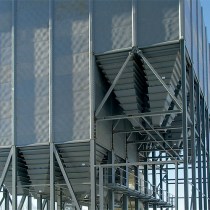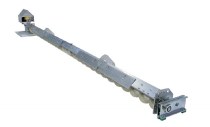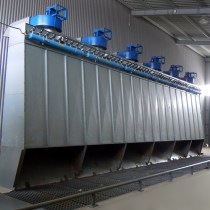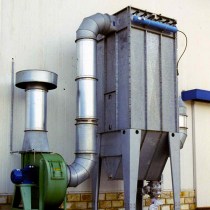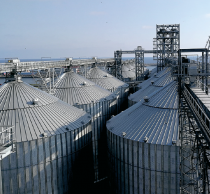Grain storage plants
We offer PETKUS technique for long- and short-term storage of different products.
PETKUS Profile Wall Silos are a modular system designed for limited space and are ideal for the storage of grain, corn, pellets and other granular and free flowing products. Profile wall silos are space-saving, stable and economical silo systems which offer compact customer-oriented solutions with regards to load and spatial requirements. The silo cells in a modular design can be installed as a battery of silos in a row or as a block with different heights and capacities. Silo cell blocks can be integrated into steel structures.
All silos meet the same structural requirements according to EUROCODE and consist of insulated wall elements bolted with countersunk flat head screws. Fast and high-quality on site assembly without welding is possible. The cell corners form hollow cavities which are filled with concrete after finishing the installation. Maximum possible volume without additional struts is 320 m ³. Sendzimir-galvanized steel or stainless steel sheets are used for the production of the individual elements for long-lasting corrosion protection. Every silo cell is equipped with a bolted outlet hopper.
PETKUS Smooth Wall Silo is a modern and efficient silo system for storing products such as seed or compound feed which must be completely emptied from the bin. Similarly, powder, fine seeds and generally poor-flowing products that require complete removal after storage can be stored here as well as products that must remain absolutely contamination free.
The modular design silo cells with different heights and capacities can be installed as a battery of silos in a row or as a block. The steel construction for a machine house can be integrated into any silo concept. The smooth double wall elements with 135 ° corners, as well as the use of flat head countersunk screws in the area of the silo supports prevent product adhesion. During emptying almost no grain remains in the silo. With the sandwich type construction, the double wall elements are inserted horizontally and are vertically bolted. Every double wall element is equipped with a lateral structure with a quarter support. During installation a hollow cavity is created, which is filled with concrete afterwards. With extremely high silo cells, silo supports can be provided with reinforcement baskets before the filling of concrete. This contributes to the static stability of the silo system. Every silo cell is equipped with a bolted or welded hopper with a spot or slot outlet.
PETKUS Buffer Silos are small, fine and incredibly practical for everyday loading, unloading or reloading. Grain or free flowing products can be stored on a short-term basis for buffering, mixing or dosing. Due to the modular design of the galvanized square silos, different heights and capacities are possible. The square silo consists of individual elements with a length of 2000 mm, 2500 mm or 3000 mm. The maximum height is 6 m (10 individual elements). Every silo is equipped with a bolted outlet hopper that is attached on supports in the corresponding height. Buffer silos are emptied at a hopper inclination of 45° or 60°, depending on the properties of the product. This makes it possible to use the buffer silo as a loading cell for trucks or railcars.
PETKUS Round Silos are practical for all types of grain, oilseeds, feed and industrial pellets. They consist of corrugated galvanized sheet steel which undergoes the Sendzimir process Z600 to provide high corrosion protection. The modular design of the round silos allows heights from 1 to 25 m and diameters from 3 to 32 m. The specifications of PETKUS steel round silos are calculated according to the product loads of ANSI/ASAE or EURO CODE. The construction is carried out in accordance to EUROCODE construction standards.
The roof of the silo is a self-supporting structure made of trapezoidal segments and equipped with ladders, filler caps and skylight observation. Round silos are equipped with inspection doors and wind rings and can also be equipped with roof and floor ventilation systems, a thermostat and a fill level sensor, resting platforms, railings and walkways.
PETKUS round silos are offered as flat bottom, hopper and loading silos. Flat bottom silos are used for long term storage, and are emptied with the help of a sweep auger according to the "first in, first out" principle. Hopper silos are emptied at a hopper inclination of 45° or 60°, depending on the properties of the product. Loading for trucks or railcars can with accomplished with a drive under loading cell.
PETKUS Sweep Augers are used for emptying flat-bottomed round silos. Granular and free-flowing bulky products such as grain, pulses, oilseeds, and similar agricultural products can be conveyed with them. The outlet hopper with the drive unit is mounted over the main outlet in the silo bottom. During the emptying process the sweep auger moves in a circular motion above the silo bottom removing the material cone and transporting the product to the main outlet in the center of the silo. This way, problems such as back logging and stoppage can be avoided.
PETKUS Dust Extractorsfor Intake Pits reduce environmentally harmful dust emission during unloading. Dusty air is aspirated by the fans in the intake pit. A hose filter separates the dust and the cleaned air is recirculated. The bag filter is cleaned with compressed air and the dust is fed back to the intake pit so that a dust collection system is not required. The dust extraction for the intake pits is installed in modules and each module is equipped with a fan and silencer that sucks the air in. Bag filters made of polyester clean the air inside the module. The modules can be optionally extended from 8 m to 18 m.
PETKUS Square Filters FV are used in grain processing plants for dust removal in exhaust air. The dusty air is aspirated by the fan which can be placed directly on the square filter or separately. The filter separates the dust on its way through the bag filters and the cleaned air is transported outwards. Dust is removed pneumatically from the filter bags. The dust is discharged over a filter hopper with an auger and a secondary rotary valve.
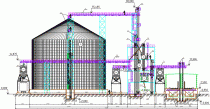
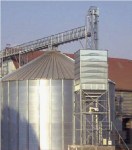
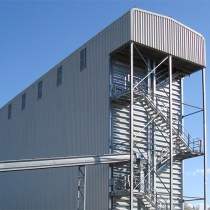
_210x150.jpg)
